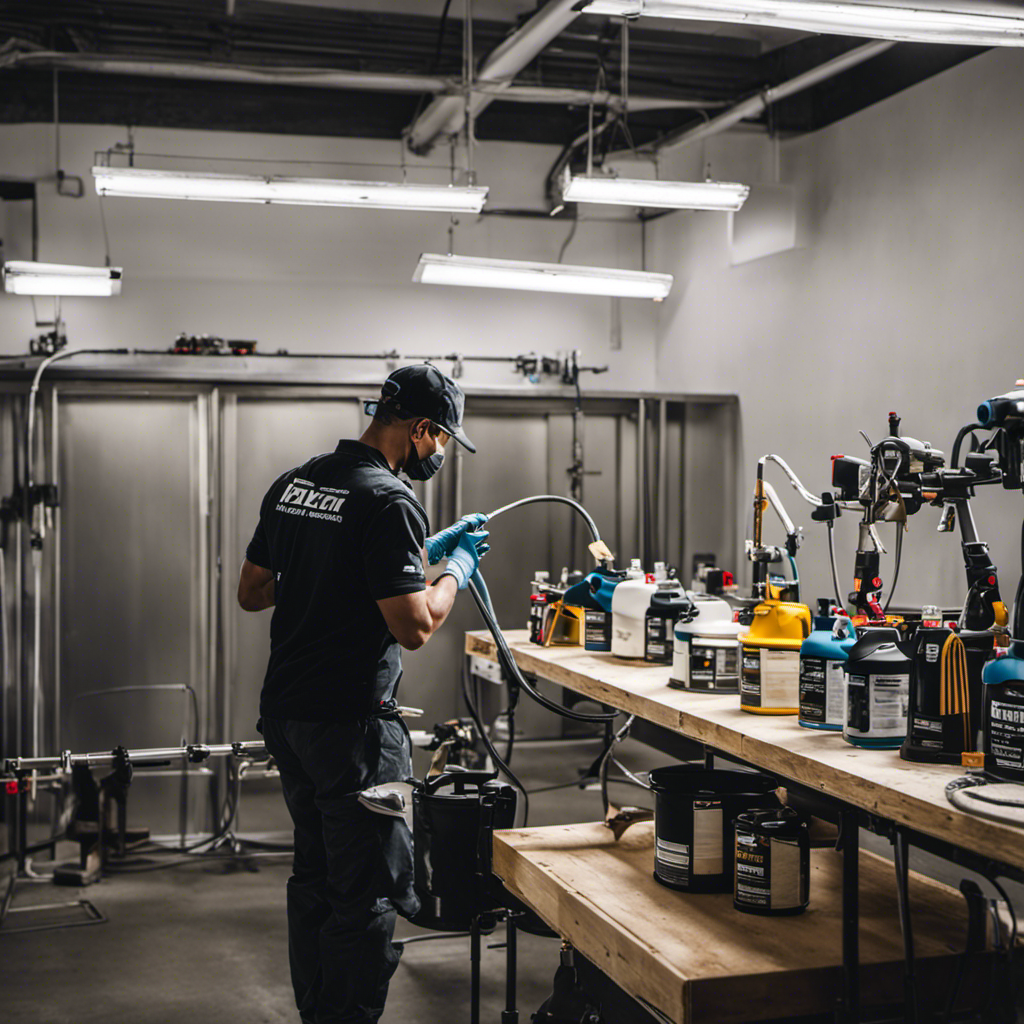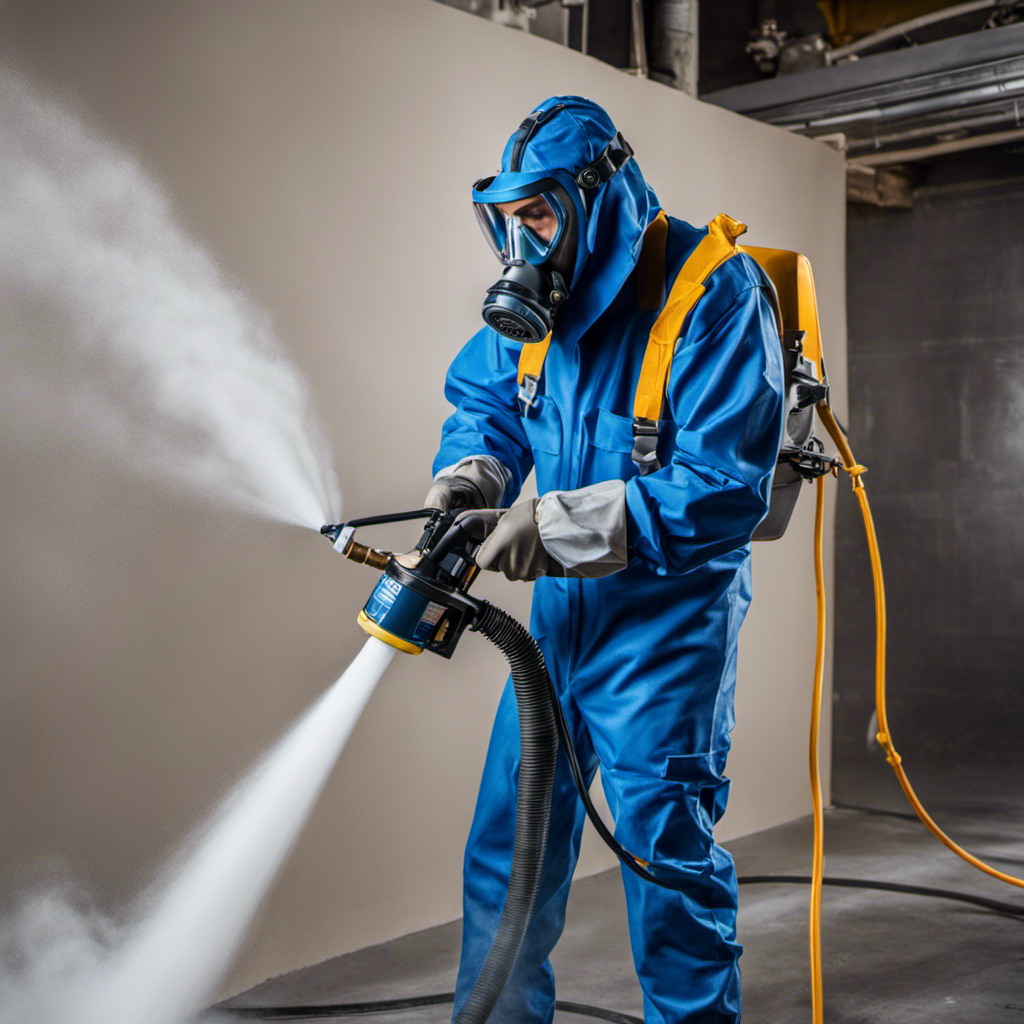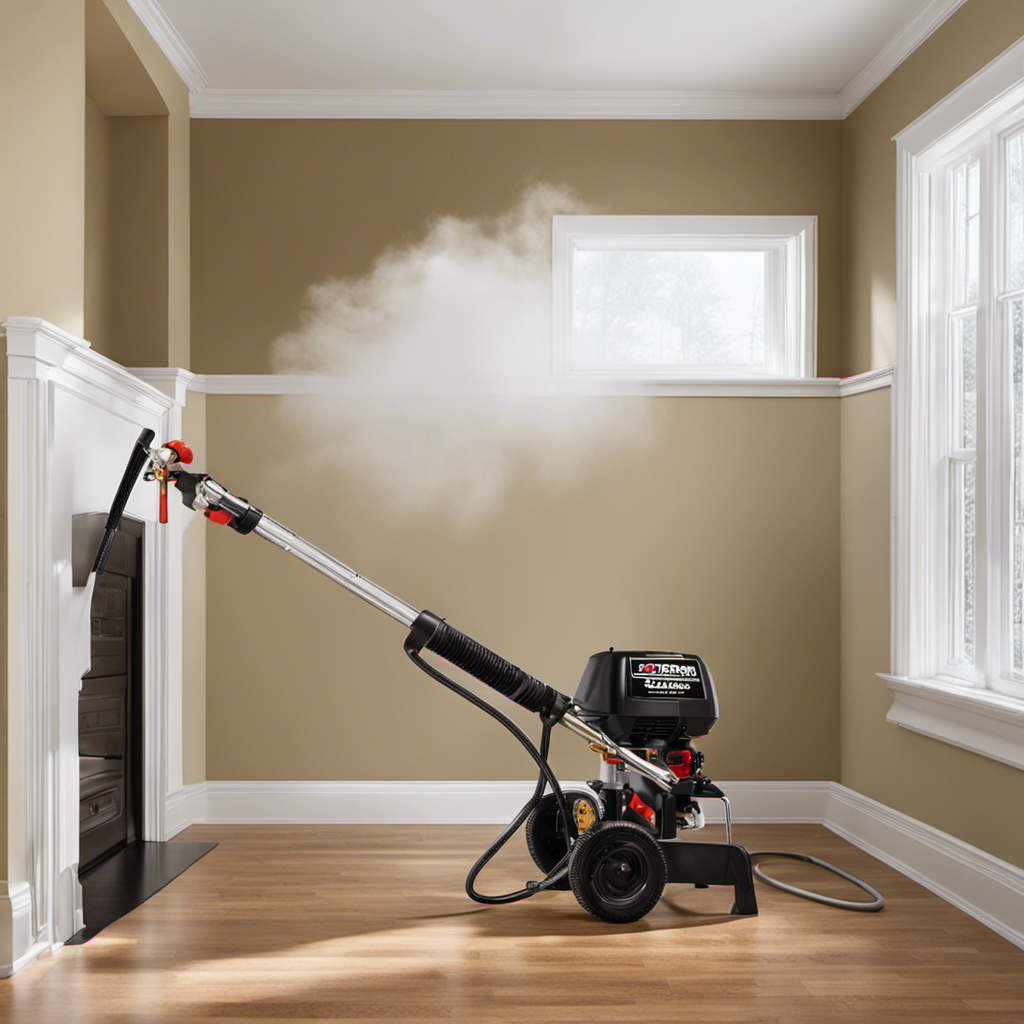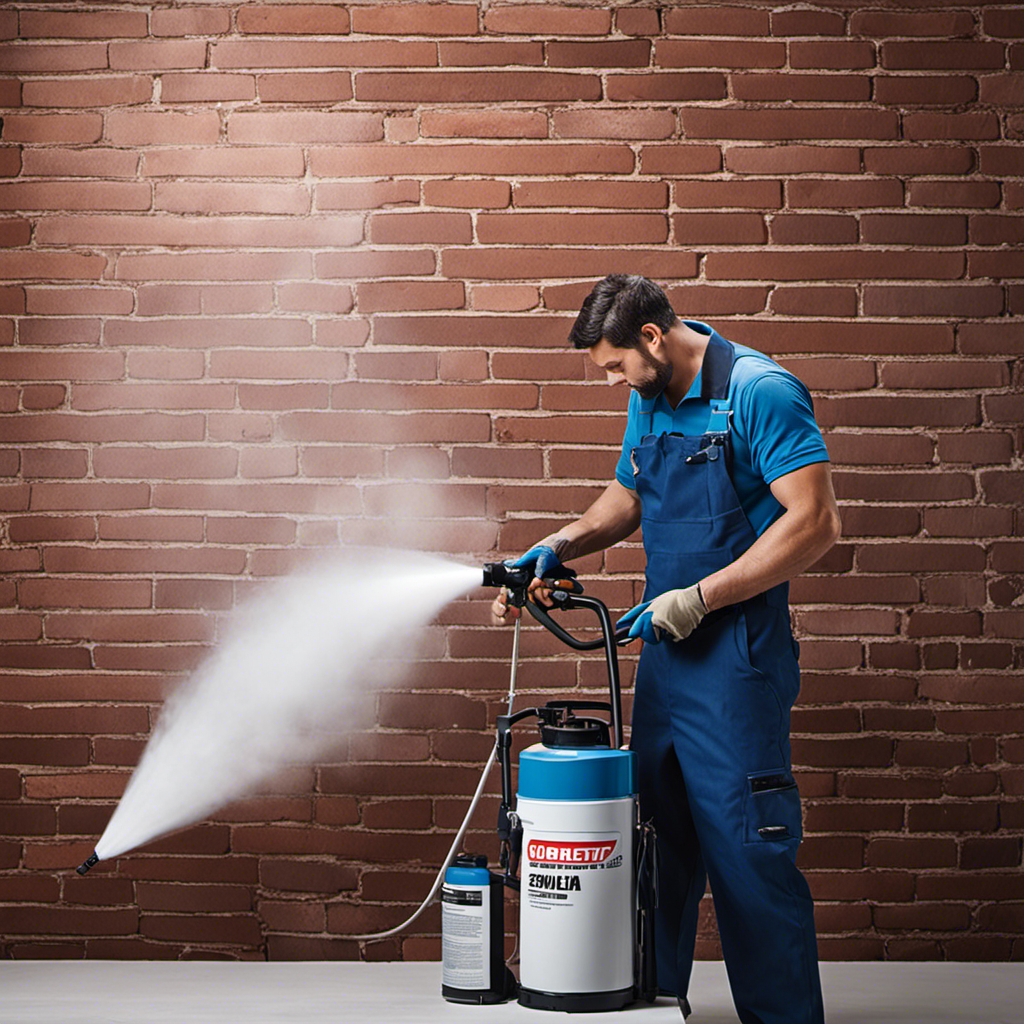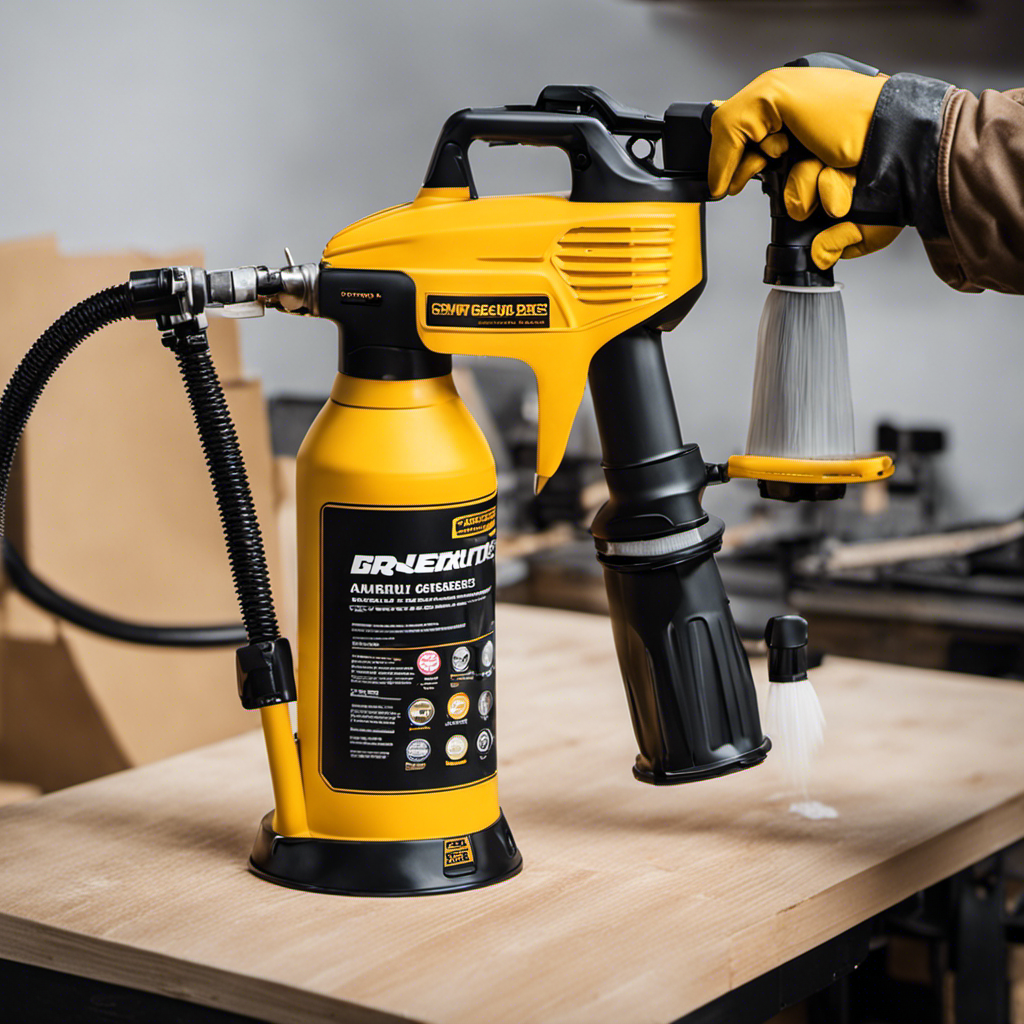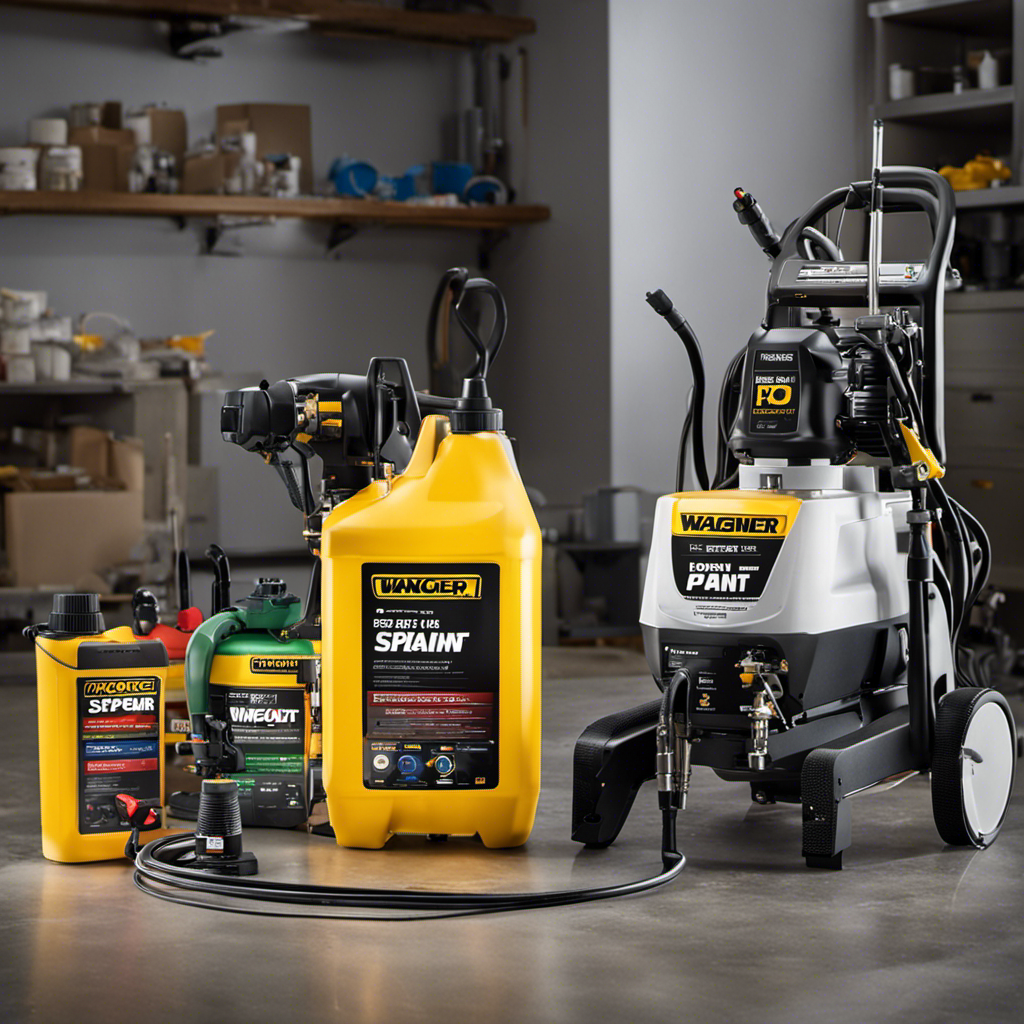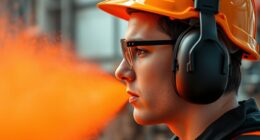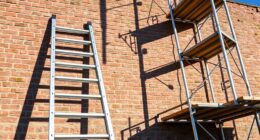In order to ensure the airless paint sprayer lasts a long time and stays operational, it is important to provide it with regular maintenance. Regularly cleaning and oiling the sprayer can potentially increase its lifespan by up to 50%.
By thoroughly cleaning the sprayer, including the paint container and spray gun, and regularly lubricating moving parts, you can achieve flawless paint finishes and prevent costly repairs.
Using a cover or case for storage protects the sprayer from dust, moisture, and damage.
In this article, we will explore the essential techniques and practices for properly caring for and maintaining your airless paint sprayer.
Key Takeaways
- Thoroughly clean the sprayer, paint container, and spray gun to remove excess paint and residue.
- Regularly lubricate moving parts and protect the sprayer from dust and debris.
- Store the airless paint sprayer in a dry and temperature-controlled area, using a cover or case for added protection.
- Regularly inspect and replace worn or damaged parts, such as the spray tip, gun filter, and pump packings.
Cleaning and Maintenance Techniques
Regularly lubricate the moving parts of the airless paint sprayer to ensure smooth operation and prevent any potential issues.
To maintain the sprayer’s efficiency, clean it thoroughly after each use. Begin by removing excess paint and then use a cleaning solution to eliminate any residue.
Empty and clean the paint container to prevent clogs or build-up. Disconnect and clean the spray gun to ensure that all paint residue is removed.
When not in use, store the airless paint sprayer in a dry and temperature-controlled area. It is recommended to use a cover or case for added protection.
Neatly wrap the power cord to prevent damage and store it in a clean and dry area.
Thoroughly Cleaning the Sprayer
To ensure optimal performance, it is important to thoroughly clean the airless paint sprayer. This can be done by removing excess paint and using a cleaning solution.
Cleaning techniques for the sprayer include emptying and cleaning the paint container. This helps prevent clogs or build-up that can affect the sprayer’s functionality.
Additionally, it is essential to disconnect and clean the spray gun. This ensures that all paint residue is removed and prevents any blockages.
Regularly lubricating moving parts is also crucial for smooth operation. This helps to maintain the sprayer’s performance and prevent any issues.
To prevent dust and debris from affecting the sprayer’s functionality, it is important to take precautions to protect it. This can include covering the sprayer when not in use or storing it in a clean and dry area.
Properly Emptying and Cleaning the Paint Container
The user should first disconnect the spray gun and thoroughly clean the paint container to prevent clogs or build-up. To empty the paint container, the user should remove any remaining paint and dispose of it properly. Then, the container should be rinsed with water or a cleaning solution to remove any residue. A brush or sponge can be used to scrub away any stubborn paint.
It’s important to ensure that the container is completely dry before reattaching it to the sprayer. This will prevent any moisture from causing clogs or affecting the paint application.
Regularly emptying and cleaning the paint container is crucial for maintaining the performance and longevity of the airless paint sprayer.
Disconnecting and Cleaning the Spray Gun
When disconnecting and cleaning the spray gun, it’s important to ensure that all paint residue is removed to maintain optimal performance. Here are some steps to follow for proper cleaning:
- Start by disconnecting the spray gun from the paint sprayer unit.
- Use a cleaning solution specifically designed for paint sprayers to remove any remaining paint residue.
- Pay close attention to the nozzle and other small parts, as they are prone to clogs.
- Use a soft brush or cloth to gently scrub away any stubborn paint.
- Rinse the spray gun thoroughly with clean water to remove any traces of the cleaning solution.
- Allow the spray gun to dry completely before reassembling it.
Regular Lubrication for Smooth Operation
Regularly lubricating the moving parts of the sprayer ensures smooth operation and helps prevent any potential issues. Lubrication benefits include reducing friction, minimizing wear and tear, and extending the lifespan of the sprayer. Proper lubrication techniques involve applying lubricant to specific components such as the piston, packings, and valves. It is important to use the right type of lubricant recommended by the manufacturer and follow the recommended schedule for lubrication. Failure to lubricate the sprayer regularly can result in decreased performance, increased maintenance needs, and potential breakdowns. To provide a visual representation of lubrication techniques, refer to the table below:
| Component | Lubrication Technique |
|---|---|
| Piston | Apply lubricant to piston rod and cylinder walls |
| Packings | Apply lubricant to packing nut and rings |
| Valves | Apply lubricant to valve stems and seats |
| Bearings | Apply lubricant to bearing surfaces |
Protecting the Sprayer From Dust and Debris
To prevent dust and debris from damaging it, users should take precautions to shield the sprayer. One effective method is to choose the right cover or case to protect the sprayer from moisture and other contaminants.
Here are some key points to consider when selecting a cover or case:
-
Material and waterproofing capabilities: Look for covers or cases made from durable materials that offer waterproofing capabilities. This will ensure that the sprayer is shielded from moisture, preventing any potential damage.
-
Design for airless paint sprayers: Opt for covers or cases specifically designed for airless paint sprayers. These are tailored to fit the sprayer properly and provide optimal protection.
Tips for Proper Storage
A dry and temperature-controlled area is ideal for storing the airless paint sprayer. This ensures that the sprayer is protected from moisture and extreme temperatures that could damage its components.
To prevent paint clogs, it is important to clean the sprayer thoroughly after each use, removing any excess paint and using a cleaning solution. Regular lubrication of the moving parts is also crucial for smooth operation and to prevent any potential issues. Lubricating the piston, seals, and other components will help maintain the sprayer’s performance.
Regular maintenance and storage in a proper environment will extend the lifespan of the sprayer and ensure optimal functionality. By following these tips, users can prevent paint clogs and enjoy the benefits of a well-maintained airless paint sprayer.
Using a Cover or Case for Added Protection
Using a cover or case with durable materials and waterproofing capabilities is recommended for added protection of the sprayer from dust, debris, and moisture. When choosing the right cover or case, it is important to consider factors such as the size and shape of the sprayer, as well as the level of protection needed.
Proper maintenance of the cover or case is also crucial to ensure its effectiveness in safeguarding the sprayer. This includes regularly cleaning the cover or case to remove any accumulated dirt or debris, and checking for any signs of wear or damage.
It is also important to store the cover or case in a dry and clean area when not in use, to prevent moisture or mold growth. By taking these steps, users can ensure that their airless paint sprayer remains protected and in optimal condition for long-lasting use.
Wrapping the Power Cord Neatly
When neatly wrapping the power cord, users should avoid excessive twisting or bending to prevent damage. Proper power cord organization is essential for maintaining the longevity of the airless paint sprayer. To convey a deeper understanding of this topic, a table is provided below:
| Common Power Cord Damage | Causes | Prevention |
|---|---|---|
| Frayed or exposed wires | – Excessive twisting | – Gently coil the cord without excessive bending |
| – Sharp bends | – Avoid wrapping the cord tightly around objects | |
| – Tugging or pulling | – Store the cord in a dry and clean area | |
| Loose connections | – Frequent plugging | – Avoid forcefully inserting or removing the plug |
| – Improper storage | – Unplug the cord properly before storage |
Regular Inspection and Maintenance During Storage
During storage, it is important for users to regularly inspect and maintain their airless paint sprayers to ensure optimal performance. Following a regular maintenance schedule and troubleshooting common issues can help prevent costly repairs and extend the lifespan of the sprayer.
Here are some important steps to consider:
Regular Maintenance Schedule:
- Clean the sprayer thoroughly to remove excess paint and prevent clogs.
- Disconnect and clean the spray gun to remove any paint residue.
- Lubricate moving parts regularly for smooth operation.
- Protect the sprayer from dust and debris.
Troubleshooting Common Issues:
- Regularly inspect the sprayer for worn or damaged parts.
- Pay close attention to components such as the spray tip, gun filter, and pump packings.
- Replace any worn parts immediately to avoid compromising functionality.
Benefits of Using a Cover or Case
A cover or case protects the sprayer from dust, debris, and moisture. Choosing the right cover or case for an airless paint sprayer offers several benefits, including waterproofing capabilities.
By selecting a cover or case with durable materials and waterproofing features, the sprayer is shielded from water damage, ensuring its longevity and functionality. Waterproofing prevents moisture from seeping into the sprayer, which can lead to corrosion and damage to the internal components.
Additionally, a cover or case provides protection against accidental bumps and scratches, further safeguarding the sprayer during storage and transportation.
When choosing a cover or case, it is important to consider the specific design and compatibility with airless paint sprayers to ensure a proper fit. By investing in a high-quality cover or case, users can extend the lifespan of their sprayer and achieve flawless paint finishes.
Checking and Replacing Worn or Damaged Parts
Inspecting the sprayer regularly for worn or damaged parts is essential to ensure its functionality and avoid any compromises in performance. Troubleshooting common issues and replacing worn parts promptly is crucial for maintaining the optimal operation of the airless paint sprayer. Here are some key points to consider:
-
Common Issues:
-
Clogged spray tip: Check for blockages and clean or replace the tip as needed.
-
Reduced pressure: Inspect the gun filter and pump packings for wear and tear, replacing them if necessary.
-
Emotional Response:
-
Frustration: Prevent frustration by addressing issues promptly for uninterrupted painting.
-
Satisfaction: Achieve smooth, flawless paint finishes by maintaining the sprayer’s performance.
Regularly refer to a table listing common worn parts and their replacements to ensure you have the necessary replacements on hand. By troubleshooting and replacing worn or damaged parts, you can keep your airless paint sprayer in optimal condition and achieve professional results.
Paying Attention to Key Components
After checking and replacing worn or damaged parts, it is important to pay attention to key components such as spray tip maintenance and pump packing replacement.
The spray tip is a crucial part of the airless paint sprayer that determines the pattern and flow of the paint. Regularly inspect the spray tip for any blockages or damage, and clean or replace it as necessary.
Additionally, the pump packing plays a vital role in preventing leaks and maintaining pressure. Over time, the pump packing may wear out and need replacement. It is essential to follow the manufacturer’s instructions to properly replace the pump packing, ensuring a tight seal and optimal performance.
Proper Power Cord Storage and Maintenance
To maintain the longevity of the power cord, the user should carefully coil it without excessive twisting or bending. This ensures that the cord remains in good condition and prevents any potential damage. Improperly coiling the cord can lead to tangling, kinks, or even breaks, which may render the cord unusable.
To prevent power cord damage, it is important to follow these guidelines:
- Avoid tightly wrapping the cord around the sprayer or other objects, as this can cause strain and potential damage.
- Store the wrapped cord in a dry and clean area to protect it from moisture and dirt.
- Regularly inspect the cord for any signs of wear or fraying and replace it if necessary.
Proper power cord organization and maintenance are essential to ensure the functionality and safety of your airless paint sprayer. By taking these precautions, you can prolong the life of your power cord and prevent any potential issues during use.
Frequently Asked Questions
Are There Any Specific Cleaning Solutions Recommended for Cleaning the Airless Paint Sprayer?
There are specific cleaning solutions recommended for cleaning the airless paint sprayer. It is important to use a cleaning solution that is compatible with the type of paint used.
The maintenance frequency of cleaning the sprayer depends on the usage and the type of paint being sprayed. Regular cleaning is necessary to prevent clogs and ensure optimal performance.
Following the manufacturer’s instructions and using the recommended cleaning solutions will help maintain the sprayer’s longevity and efficiency.
How Often Should the Sprayer Be Lubricated for Smooth Operation?
To ensure smooth operation, the airless paint sprayer should be lubricated regularly. The frequency of lubrication depends on the manufacturer’s recommendations, but a general rule of thumb is to lubricate the moving parts every 50-75 hours of use.
The best lubricants for an airless paint sprayer are silicone-based lubricants or specific sprayer lubricants recommended by the manufacturer. Proper lubrication helps reduce friction and wear, prolonging the lifespan of the sprayer and ensuring flawless paint finishes.
Can the Airless Paint Sprayer Be Stored in a Garage or Does It Need a Temperature-Controlled Area?
The airless paint sprayer can be stored in a garage, but it’s recommended to store it in a temperature-controlled area for optimal performance.
Garage storage may expose the sprayer to temperature fluctuations and humidity, which can affect its functionality and lifespan.
Storing the sprayer in a temperature-controlled area ensures that it is protected from extreme temperatures and moisture, preserving its quality and preventing damage.
What Should I Do if I Notice Any Leaks or Clogs in the Spray Gun?
If any leaks or clogs are noticed in the spray gun of an airless paint sprayer, there are a few steps that can be taken to address the issue.
First, check the connections between the gun and the hose to ensure they are tight and secure.
If there are any clogs, try removing the spray tip and cleaning it thoroughly.
It’s also important to inspect the gun filter and clean or replace it if necessary.
Is It Necessary to Replace All Worn Parts Immediately or Are There Some That Can Be Repaired?
Repair vs. Replacement is a crucial consideration when dealing with worn parts of an airless paint sprayer. While some components can be repaired, it is generally recommended to replace worn parts immediately to maintain optimal functionality.
Regular maintenance tips include inspecting the sprayer for worn or damaged parts, paying close attention to the spray tip, gun filter, and pump packings.
Conclusion
In conclusion, the meticulous care and maintenance of an airless paint sprayer are paramount for its optimal performance and extended lifespan. By implementing thorough cleaning techniques, proper lubrication, and regular inspection of worn parts, one can achieve flawless paint finishes.
Utilizing a cover or case safeguards the sprayer from dust, moisture, bumps, and scratches, ensuring its longevity. Additionally, paying attention to key components and practicing proper power cord storage will contribute to the sprayer’s smooth operation.
Remember, a well-maintained airless paint sprayer promises pristine results and prolonged functionality.
Drenched in creativity and armed with a fountain pen, Isolde weaves words as gracefully as a painter strokes their canvas. A writer for Paint Sprayer Zone, her passion for colors, textures, and spaces finds a harmonious blend with her profound knowledge of painting tools and techniques.
Having grown up in a family of artists, Isolde’s tryst with paints began early. While her relatives expressed themselves on canvas, Isolde found her medium in words. She dedicated herself to chronicling the world of painting, understanding the nuances of each tool, and the artistry behind every spritz of a paint sprayer.
